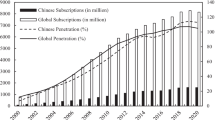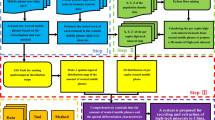Abstract
The goal of this work is to evaluate generation and metals recycling potentials of retired mobile phones in Korea. The generation estimation is conducted with the sales&new method and statistic data, such as sales of mobile phones and amount of the subscribers. The result shows that there are 17.99 million of mobile phones retired in 2022, compared 13.12 million in 2001. Accordingly, the deduced lifetime has minimum and maximum values in 2003 and 2020, which are 2.02 and 4.33 years, compared with 4.16 years in 2022 and 2.21 years in 2001. The deduced lifetime trends to increase with the increased values of subscribers and the fluctuated values of sales. The crosscheck testifies to the veracity of the result in comparison with the actual condition. The amount and dynamic of critical metals are also calculated with the content and amount of retired mobile phones.





Similar content being viewed by others
Data availability
The data sets used during the current study are available from the corresponding author on reasonable request.
References
Abbondanza MNM, Souza RG (2019) Estimating the generation of household e-waste in municipalities using primary data from surveys: a case study of Sao Jose dos Campos, Brazil. Waste Manage 85:374–384
Ahmed S, Panwar RM (2016) Hazardous constituents of e-waste and predictions for India. Proc Inst Civ Eng Waste Resour Manag 169:83–91
Althaf S, Babbitt CW, Chen R (2020) The evolution of consumer electronic waste in the United States. J Ind Eco 25:693–706
Andarani P, Goto N (2013) Potential e-waste generated from households in Indonesia using material flow analysis. J Mater Cycles Waste Manage 16:306–320
Araujo MG, Magrini A, Mahler CF, Bilitewski B (2012) A model for estimation of potential generation of waste electrical and electronic equipment in Brazil. Waste Manage 32:335–342
Araujo DRR, de Oliveira JD, Selva VF, Silva MM, Santos SM (2017) Generation of domestic waste electrical and electronic equipment on Fernando de Noronha Island: qualitative and quantitative aspects. Environ Sci Pollut Res 24:19703–19713
Cai K, Song Q, Peng S, Yuan W, Liang Y, Li J (2020) Uncovering residents’ behaviors, attitudes, and WTP for recycling e-waste: a case study of Zhuhai city, China. Environ Sci Pollut Res 27:2386–2399
Cai K, Wang L, Ke J, He X, Song Q, Hu J, Yang G, Li J (2023) Differences and determinants for polluted area, urban and rural residents’ willingness to hand over and pay for waste mobile phone recycling: evidence from China. Waste Manage 157:290–300
Forti V, Baldé K, Kuehr R (2018)E-waste statistics: guidelines on classifications, reporting and indicators, second edition, United Nations University, ViE – SCYCLE, Bonn, Germany
Golev A, Werner TT, Zhu X, Matsubae K (2016) Product flow analysis using trade statistics and consumer survey data: a case study of mobile phones in Australia. J Clean Prod 133:262–271
He P, Wang C, Zuo L (2018) The present and future availability of high-tech minerals in waste mobile phones: evidence from China. J Clean Prod 192:940–949
He P, Hu G, Wang C, Hewage K, Sadiq R, Feng H (2020) Analyzing present and future availability of critical high-tech minerals in waste cellphones: a case study of India. Waste Manage 119:275–284
Ikhlayel M (2016) Differences of methods to estimate generation of waste electrical and electronic equipment for developing countries: Jordan as a case study. Resour Conserv Recy 108:134–139
Işıldar A, Rene ER, van Hullebusch ED, Lens PNL (2018) Electronic waste as a secondary source of critical metals: management and recovery technologies. Resour Conserv Recy 135:296–312
ITU (2022) Mobile-cellular subscriptions. https://www.itu.int/en/ITU-D/Statistics/Documents/statistics/2022/December/MobileCellularSubscriptions_2000–2021.xlsx. Accessed 6 June 2023
Jang YC, Kim M (2010) Management of used & end-of-life mobile phones in Korea: a review. Resour Conserv Recy 55:11–19
Kahar INS, Othman N, Noah NFM, Suliman SS (2023) Recovery of copper and silver from industrial e-waste leached solutions using sustainable liquid membrane technology: a review. Environ Sci Pollut Res 30:66445–66472
Kastanaki E, Giannis A (2022) Forecasting quantities of critical raw materials in obsolete feature and smart phones in Greece: a path to circular economy. J Environ Manage 307:114566
Kim S, Oguchi M, Yoshida A, Terazono A (2013) Estimating the amount of WEEE generated in South Korea by using the population balance model. Waste Manage 33:474–483
Kiran M, Shanmugam PV, Mishra A, Mehendale A, Nadheera Sherin HR (2021) A multivariate discrete grey model for estimating the waste from mobile phones, televisions, and personal computers in India. J Clean Prod 293:126185
Lee K, Cha J (2020) Towards improved circular economy and resource security in South Korea. Sustainability 13(17):10017
Lee BG, Kwak JH, Kim KY, Kim SJ (2009) Technical innovation and 3.5 mobile phone generation: lessons from Korea. Telecommun Policy 33:296–308
Li B (2015) Life cycle analysis and management countermeasure of retired mobile phones in China. Chinese Academy of Sciences, Beijing
Li S, Sun Q (2023) Evolutionary game analysis of WEEE recycling tripartite stakeholders under variable subsidies and processing fees. Environ Sci Pollut Res 30:11584–11599
Li B, Yang J, Lu B, Song X (2015) Estimation of retired mobile phones generation in China: a comparative study on methodology. Waste Manage 35:247–254
Li J, Song X, Yang D, Li B, Lu B (2020) Simulating the interprovincial movements of waste mobile phones in China based on the current disassembly capacity. J Clean Prod 244:118776
Li A, Li B, Liu X, Zhang Y, Zhang H, Lei X, Hou S, Lu B (2022a) Characteristics and dynamics of university students’ awareness of retired mobile phones in China. Sustainability 14(17):10587
Li A, Li B, Lu B, Yang D, Hou S, Song X (2022b) Generation estimation and material flow analysis of retired mobile phones in China. Environ Sci Pollut Res 29:75626–75635
Martin Eugster, Roland Hischer, Duan H (2007) Key environmental impacts of the Chinese EEE Industry, EMPA,Tsinghua University
MSIT (2023) https://www.msti.go.kr. Accessed 6 June 2023
Öztürk T (2014) Generation and management of electrical–electronic waste (e-waste) in Turkey. J Mater Cycles Waste Manage 17:411–421
Palanisamy K, Subburaj RG (2023) Integration of electronic waste management: a review of current global generation, health impact, and technologies for value recovery and its pertinent management technique. Environ Sci Pollut Res 30:63347–63367
Pathak P, Srivastava RR, Ojasvi (2017) Assessment of legislation and practices for the sustainable management of waste electrical and electronic equipment in India. Renew Sust Energy Rev 78:220–232
Polak M, Drapalova L (2012) Estimation of end of life mobile phones generation: the case study of the Czech Republic. Waste Manage 32:1583–1591
Pouyamanesh S, Kowsari E, Ramakrishna S, Chinnappan A (2023) A review of various strategies in e-waste management in line with circular economics. Environ Sci Pollut Res 30:93462–93490
Rasheed R, Rizwan A, Javed H, Sharif F, Yasar A, Tabinda AB, Mahfooz Y, Ahmed SR, Su Y (2022) Analysis of environmental sustainability of e-waste in developing countries - a case study from Pakistan. Environ Sci Pollut Res 29:36721–36739
Saidan M, Tarawneh A (2015) Estimation of potential e-waste generation in Jordan. Ekoloji, 60–64
Sellcell (2023) https://www.sellcell.com/how-many-mobile-phones-are-sold-each-year/#sources-and-media-contacts. Accessed 6 June 2023
Srivastav AL, Markandeya PN, Pandey M, Pandey AK, Dubey AK, Kumar A, Bhardwaj AK, Chaudhary VK (2023) Concepts of circular economy for sustainable management of electronic wastes: challenges and management options. Environ Sci Pollut Res 30:48654–48675
Tan Q, Dong Q, Liu L, Song Q, Liang Y, Li J (2017) Potential recycling availability and capacity assessment on typical metals in waste mobile phones: a current research study in China. J Clean Prod 148:509–517
Twagirayezu G, Uwimana A, Kui H, Birame CS, Irumva O, Nizeyimana JC, Cheng H (2023) Towards a sustainable and green approach of electrical and electronic waste management in Rwanda: a critical review. Environ Sci Pollut Res 30:77959–77980
Vidal I, Sucozhanay G, Haupt M, Vanegas P (2023) Towards the definition of WEEE recycling targets in Ecuador. A case of study for mobile phones. Waste Manage Res 41:1539–1548
Wang F, Huisman J, Stevels A, Balde CP (2013) Enhancing e-waste estimates: improving data quality by multivariate Input-Output Analysis. Waste Manage 33:2397–2407
Wang HG, Wu YF, Gu YF, Mu XZ (2016) An evaluation of potential yield of indium recycled from waste mobile phone in China. Mater Sci Forum 847:335–343
Yuksekdag A, Kose-Mutlu B, Zeytuncu-Gokoglu B, Kumral M, Wiesner MR, Koyuncu I (2022) Process optimization for acidic leaching of rare earth elements (REE) from waste electrical and electronic equipment (WEEE). Environ Sci Pollut Res 29:7772–7781
Zeng X, Gong R, Chen WQ, Li J (2016) Uncovering the recycling potential of “new” WEEE in China. Environ Sci Technol 50:1347–1358
Zeng X, Ali SH, Li J (2021) Estimation of waste outflows for multiple product types in China from 2010–2050. Sci Data 8:15
Acknowledgements
The authors are grateful to the honored editors and referees for their hard work and selfless help.
Funding
This research was funded by the National Key Research and Development Program of China (2022YFC3901705); the Science Research Project of Hebei Education Department (QN2023216); Sichuan Research Center for Mineral Resources (SCKCZY2023-YB004); the S&T Program of Xingtai (2022ZZ094) and Xingtai Polytechnic College (202304).
Author information
Authors and Affiliations
Contributions
Ang Li: conceptualization, funding acquisition, methodology, writing—original draft, visualization. Bo Li: conceptualization, funding acquisition, methodology, writing—review and editing, visualization. Huibin Wang: resources, writing—review and editing. Xia Liu: resources, writing—review and editing. Yanan Guo: writing—review and editing. Bin Lu: conceptualization, funding acquisition, writing—review and editing. All authors read and approved the final manuscript.
Corresponding author
Ethics declarations
Ethics approval and consent to participate
Not applicable.
Consent for publication
Not applicable.
Competing interests
The authors declare no competing interests.
Additional information
Responsible Editor: Philippe Garrigues
Publisher's Note
Springer Nature remains neutral with regard to jurisdictional claims in published maps and institutional affiliations.
Supplementary Information
Below is the link to the electronic supplementary material.
Rights and permissions
Springer Nature or its licensor (e.g. a society or other partner) holds exclusive rights to this article under a publishing agreement with the author(s) or other rightsholder(s); author self-archiving of the accepted manuscript version of this article is solely governed by the terms of such publishing agreement and applicable law.
About this article
Cite this article
Li, A., Li, B., Wang, H. et al. Generation estimation and metals recycling potentials evaluation of retired mobile phones in Korea. Environ Sci Pollut Res 30, 110481–110488 (2023). https://doi.org/10.1007/s11356-023-30074-x
Received:
Accepted:
Published:
Issue Date:
DOI: https://doi.org/10.1007/s11356-023-30074-x




